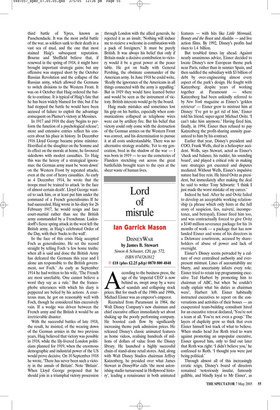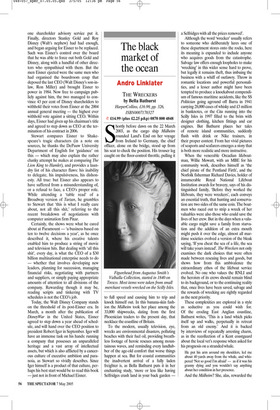Lord of misrule
Ian Garrick Mason
DISNEYWAR by James B. Stewart Simon & Schuster, £20, pp. 572, ISBN 0743263812 ✆ £18 (plus £2.25 p&p) 0870 800 4848 According to the business press, the age of the ‘imperial CEO’ is now behind us, swept away by a wave of scandals and collapsing stock prices. But for much of the 1980s and 1990s, Michael Eisner was an emperor’s emperor.
Recruited from Paramount in 1984, the Walt Disney Company’s new chairman and chief executive officer immediately set about shaking up the poorly performing company. He boosted cash flow by significantly increasing theme park admission prices. He released Disney’s classic animated features as home videos, realising hundreds of millions of dollars of value from the Disney library. He launched a highly successful chain of stand-alone retail stores. And, along with Walt Disney Studios chairman Jeffrey Katzenberg, he presided over what James Stewart in DisneyWar calls ‘the most astonishing studio turnaround in Hollywood history’, leading a renaissance in both animated features — with hits like Little Mermaid, Beauty and the Beast and Aladdin — and live action films. By 1992, Disney’s profits had risen to 1.4 billion.
But troubled times lay ahead. Against nearly unanimous advice, Eisner decided to locate Disney’s new European theme park near Paris, rather than in sunnier Spain, and then saddled the subsidiary with $3 billion of debt by over-engineering almost every aspect of the park’s design. He fought with Katzenberg: despite years of working together at Paramount — where Katzenberg had been unkindly referred to by New York magazine as Eisner’s ‘golden retriever’ — Eisner grew to mistrust him at Disney: ‘I’ve got to get rid of him,’ Eisner told his friend, super-agent Michael Ovitz. ‘I can’t take him anymore.’ Having fired him, finally, in 1994, Eisner then refused to pay Katzenberg the profit-sharing annuity guaranteed to him by his contract.
Earlier that year, Disney’s president and COO, Frank Wells, died in a helicopter accident. Wells, says Stewart, acted as Eisner’s ‘check and balance, his rudder, his sounding board’, and played a critical role in making sure strategies got executed and disputes mediated. Without Wells, Eisner’s impulsive nature had free rein. He hired Ovitz as president, but immediately after making the deal he said to writer Tony Schwartz: ‘I think I just made the worst mistake of my career.’ Indeed he had. After he and Ovitz failed to develop an acceptable working relationship (a phrase which only hints at the full story of suspicion, lies, naiveté, incompetence, and betrayal), Eisner fired him too, and was contractually forced to give Ovitz a $140 million severance package for his 16 months of work — a package that has now landed Eisner and some of his directors in a Delaware courtroom, accused by shareholders of abuse of power and lack of oversight.
Eisner’s Disney seems pervaded by a culture of over centralised authority and everpresent mistrust. Lines of accountability are blurry, and uncertainty infects every role: Eisner tried to retain top programming executive Ted Harbert by promoting him to chairman of ABC, but when ‘he couldn’t really explain what his duties as chairman were’, Harbert left. Eisner habitually instructed executives to report on the conversations and activities of their bosses — an exasperated team-building consultant hired for an executive retreat declared, ‘You’re not a team at all. You’re not even a group.’ The layers of duplicity grew so thick that even Eisner himself lost track of what to believe. When studio head Joe Roth tried to warn against promoting an unpopular executive, Eisner ignored him, only to find out later that Roth was right: ‘I didn’t believe you,’ he confessed to Roth. ‘I thought you were just being political.’ Through almost all of this increasingly erratic reign, Disney’s board of directors remained ‘notoriously insular, famously gullible, and blindly loyal to Mr Eisner’, as one shareholder advisory service put it. Finally, directors Stanley Gold and Roy Disney (Walt’s nephew) had had enough, and began arguing for Eisner to be replaced. Such was Eisner’s control over the board that he was able to force out both Gold and Disney, along with a handful of other directors who sympathised with them. But the men Eisner ejected were the same men who had organised the boardroom coup that deposed the last CEO (Walt Disney’s son-inlaw, Ron Miller) and brought Eisner to power in 1984. Now free to campaign publicly against him, the two managed to convince 43 per cent of Disney shareholders to withhold their votes from Eisner at the 2004 annual general meeting — the highest ever withhold vote against a sitting CEO. Within days, Eisner had given up his chairman’s title and agreed to step down as CEO at the termination of his contract in 2006.
Stewart compares Eisner to Shakespeare’s tragic characters (in a note on sources, he thanks the DePauw University Department of English for ‘guidance’ on this — which may also explain the rather clunky attempt he makes at comparing The Lion King to Hamlet), and provides a laundry list of his character flaws: his inability to delegate, his impulsiveness, his dishonesty. All true: but Eisner also appears to have suffered from a misunderstanding of, or a refusal to face, a CEO’s proper role. While attending a ‘table read’ of a Broadway version of Tarzan, he grumbles to Stewart that ‘this is what I really care about, not all this shit,’ referring to the recent breakdown of negotiations with computer animation firm Pixar.
Certainly, the shows were what he cared about at Paramount — ‘a business based on ten to twelve decisions a year’, as he once described it, where his creative talents enabled him to produce a string of movie and television hits. But dealing with ‘all this shit’, every day, is what the CEO of a $30 billion multinational enterprise needs to do — whether that involves developing new leaders, planning for succession, managing financial risks, negotiating with partners and suppliers, or simply paying appropriate amounts of attention to all divisions of the company. Rewarding though it may be, reading scripts and tinkering with TV schedules is not the CEO’s job.
Today, the Walt Disney Company stands on the threshold of its post-Eisner era. In March, a month after the publication of DisneyWar in the United States, Eisner agreed to step down a year ahead of schedule, and will hand over the CEO position to president Robert Iger in September. Iger will have an immense task on his hands: running a company that possesses an unparalleled heritage and a vast array of intellectual assets, but which is also afflicted by a cancerous culture of executive ambition and paranoia, as Stewart so vividly describes. Since Iger himself is a product of that culture, perhaps his best start would be to read this book — just not in front of Michael Eisner.




























































 Previous page
Previous page